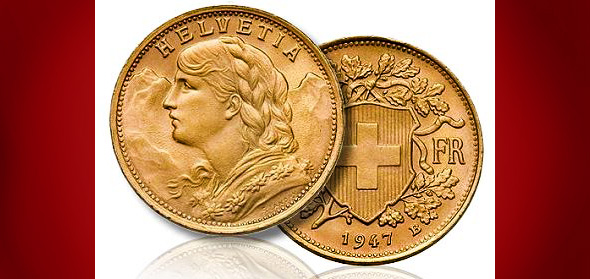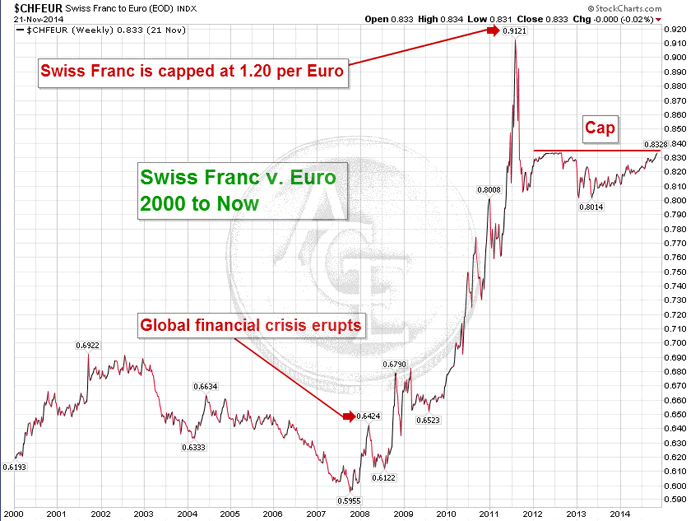by Dana Samuelson – American Gold Exchange

On Sunday, the citizens of Switzerland will cast a historic vote to determine how their government will maintain its future financial health. The referendum is known as the Swiss Gold Initiative. Its tacit goal is to lower government debt and support the Swiss franc by returning to traditional Swiss values of fiscal responsibility. The way to achieve these ends, according to the initiative, is to rebuild Switzerland’s fiscal strength on a permanent foundation of gold.
This initiative would amend the Swiss constitution in three important ways:
1. The Swiss National Bank would be prohibited by law from selling any of its gold reserves.
2. All of the nation’s gold reserves would be held in Switzerland. Currently, 20% are held at the Bank of England and 10% at the Bank of Canada.
3. The Swiss National Bank would be required to maintain at least 20% of its total assets in gold, whereas it currently holds just 7.5%, or 1,040 tonnes.
To win, it must garner a majority of the popular vote and pass in a majority of the cantons, which are like states here in the U.S. If that happens, the SNB will have two years to repatriate its gold back to Switzerland, and five years to build its gold reserves up to 20% from the current 7.5% of total reserves. Analysts estimate that the SNB will have to buy around 1,500 tonnes of gold to come into compliance.
A Grassroots Movement
The SGI is a grassroots movement aiming to reverse a series of events that have undermined traditional Swiss notions of fiscal responsibility. Since 2008, the Swiss national debt has risen by approximately 300%, and nearly half of that increase has occurred since 2011, when the Swiss government decided to peg the value of its franc at 1.20 per euro.
If you look at the chart below, you can see how strongly the Swiss franc rose against the euro following the start of global financial crisis in 2008. By May 2011, the safe-haven franc had risen about 50% against the euro, rendering Swiss exports uncompetitive. Drastic measures were required, so Switzerland pegged its franc at 1.20 per euro, well below market value.

In effect, the Swiss government devalued its currency to keep pace with other major nations that were devaluing theirs through extraordinary monetary stimulus. The Swiss Gold Initiative arises from a popular desire to hedge against this currency devaluation and its associated surge in national debt by dramatically rebuilding the depleted Swiss gold holdings, around half of which were sold off from 2000 to 2005.
The Swiss are not the only Europeans trying to re-anchor their nation’s finances with physical gold. Since the 1950s, it’s been common practice for central banks to store portions of their physical gold reserves in major financial centers such as New York and London to facilitate trade. This expatriation of physical gold was especially useful prior to the abandonment of the gold standard by the U.S. in the 1970s. But now, with so much debt and currency debasement in the world’s major economies, some citizens and central bankers want their national gold back.
Last year, anxious about the fiscal trends of the Eurozone, U.S., and other major economies, Germany voted to audit and repatriate much of its physical gold stored beyond its borders, gold that had never before been physically audited. With the world’s second-largest gold reserves (after the U.S.) at 3,385 tons, Germany was keeping only around 30% on German soil. Now it will have to increase that amount to 50% by 2020.
Last week, it was revealed that the Netherlands, too, has quietly repatriated about 20%, or 122 tons, of its physical gold from New York. Until recently, only 11% of the nation’s gold reserves were held on Dutch soil, with 51% held in New York and the remainder in Canada and the U.K. Now, the Dutch will keep 31% in the Netherlands, with 31% in New York, 20% in Canada, and 18% in London.
The Risks of Unprecedented Global Easing
Since 2008, the U.S. has effectively printed some $3 trillion through the Fed’s three installments of quantitative easing after slashing interest rate nearly to zero. Japan’s monetary easing has driven the yen to a seven-year low against the dollar, a trend that is likely to accelerate further under Abenomics. The European Central Bank recently started purchasing private bonds and asset-backed securities to provide more liquidity to the struggling Eurozone, and is on the verge of full-blown Fed-style quantitative easing. And China announced new broad-based monetary stimulus by cutting interest rates just last week. Everybody’s doing it, and they have been for years.
All of these policies have one thing in common: they make money cheaper and more plentiful. It’s no wonder fiscally-conservative societies like Germany, the Netherlands, and Switzerland wish to fight back by returning to gold. The yellow metal has a long history as an effective and popular hedge against currency devaluation and the erosion of purchasing power.
The dollar has been in an uptrend recently as other major currencies weaken under the pressure of expanded easing. This rally has weighed on the gold price in dollars but not in yen, euros or Swiss francs. Today, global currency risk is real and growing. While QE3 in the U.S. has ended, the rampant creation of new money elsewhere has increased. The world’s tsunami of cheap cash will continue to swell, even if it swells with relatively more euros, yen, and yuan. It’s why central banks around the world will buy another 400 to 500 tons of gold this year, according to the World Gold Council. It’s why nations are bringing their physical gold home again. And it’s why the Swiss people have brought this gold referendum to a vote.
Gold Market Implications
If the Swiss Gold Initiative passes, the implications for the gold market will be immediate and substantial. First, the gold price would jump around $100 or more, in our estimation. The market would certainly view a yes-vote as psychologically bullish, supplying a reason for traders to buy back short positions, fueling a substantial rally. Second, the Swiss would suddenly be in the market to accumulate a lot of physical gold, which could buoy the gold price in the longer term, just as official purchases by China, India, Russia and other emerging markets have supported gold over the last few years. After all, the mandated Swiss buys would add another 300 tonnes—around 7%—to global gold demand each year for the next five years.
A no-vote would have less of an impact, in the same way that the failure of the recent referendum on Scottish independence was essentially a non-event for the market. Still, we’d expect the gold price to sag $20 to $30 in the short term as traders who have gamed a potential yes-vote into their strategies unwind those positions.
While polls at times have shown support for the Swiss Gold Initiative above 40%, the current indications are that it’s unlikely to pass. However, the fact that it even came to ballot tells you why this vote matters. There’s a growing groundswell of public sentiment that wants to return to gold as a hedge against the excesses of governments, fiat currencies, and unbridled debt. We expect this trend to continue as the risky consequences of so many years of easy money become more apparent. Over the long term, as it always has, gold offers proven protection for wealth and purchasing power—for individuals and for nations.




